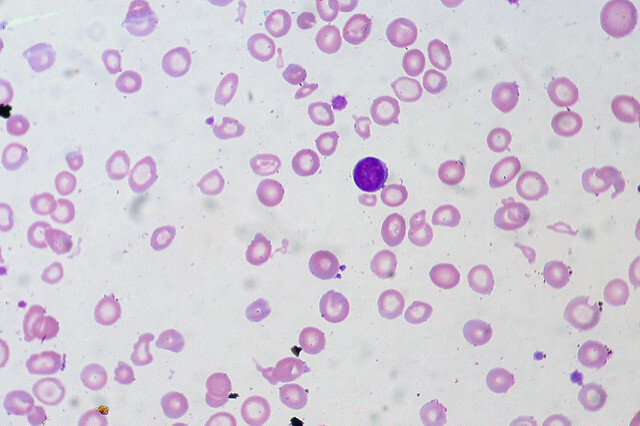Dysfunctional uterine bleeding laboratory findings: Difference between revisions
(added image for Iron deficiency anemia) |
m (corrected my personal editor hyperlink) |
||
| (2 intermediate revisions by the same user not shown) | |||
| Line 1: | Line 1: | ||
__NOTOC__ | __NOTOC__ | ||
{{Dysfunctional uterine bleeding}} | {{Dysfunctional uterine bleeding}} | ||
{{CMG}} {{AE}} [[User:AroojNaz|Arooj Naz]], {{VVS}} | {{CMG}}; {{AE}} [[User:AroojNaz|Arooj Naz, M.B.B.S]], {{VVS}} | ||
==Overview== | ==Overview== | ||
Women afflicted with dysfunctional uterine bleeding commonly present with CBC changes, particularly changes in red blood cells. Significant laboratory findings may include coagulation profile changes | Women afflicted with [[dysfunctional uterine bleeding]] commonly present with [[CBC]] changes, particularly changes in [[red blood cells]]. Significant laboratory findings may include [[coagulation]] profile changes, hormonal levels as well as [[biomedical]] markers to detect underlying [[malignancies]]. | ||
==Laboratory Findings== | ==Laboratory Findings== | ||
| Line 11: | Line 11: | ||
====CBC<ref name="pmid304225082">{{cite journal| author=| title=StatPearls | journal= | year= 2022 | volume= | issue= | pages= | pmid=30422508 | doi= | pmc= | url= }}</ref>==== | ====CBC<ref name="pmid304225082">{{cite journal| author=| title=StatPearls | journal= | year= 2022 | volume= | issue= | pages= | pmid=30422508 | doi= | pmc= | url= }}</ref>==== | ||
#[[RBC]]: Iron deficiency anemia may be seen; Microcytic, hypochromic anemia with central pallor and target like cells[[File:Anemia Reticulocyte red blood cell.jpeg|none|thumb|640x640px|Iron deficiency anemia; PMID: 28846348]] | #[[RBC]]: [[Iron deficiency anemia]] may be seen; [[Microcytic]], [[hypochromic]] anemia with [[central pallor]] and [[Target cells|target like cells]][[File:Anemia Reticulocyte red blood cell.jpeg|none|thumb|640x640px|Iron deficiency anemia; PMID: 28846348]] | ||
#[[WBC]]: [[leukocytosis]]: normal | #[[WBC]]: [[leukocytosis]]: normal | ||
#[[Platelets]]: changes in platelet count may be seen if coagulopathy is the underlying cause | #[[Platelets]]: changes in platelet count may be seen if [[coagulopathy]] is the underlying cause | ||
'''[[Coagulation|Coagulation Profile]]'''<ref name="pmid32491756">{{cite journal| author=| title=StatPearls | journal= | year= 2022 | volume= | issue= | pages= | pmid=32491756 | doi= | pmc= | url= }}</ref> | '''[[Coagulation|Coagulation Profile]]'''<ref name="pmid32491756">{{cite journal| author=| title=StatPearls | journal= | year= 2022 | volume= | issue= | pages= | pmid=32491756 | doi= | pmc= | url= }}</ref> | ||
| Line 19: | Line 19: | ||
*[[Platelets]]: changes in platelet count may be seen if coagulopathy is the underlying cause | *[[Platelets]]: changes in platelet count may be seen if coagulopathy is the underlying cause | ||
*[[PT]], [[aPTT]] and [[bleeding time]] vary depending on the underlying [[coagulopathy]] | *[[PT]], [[aPTT]] and [[bleeding time]] vary depending on the underlying [[coagulopathy]] | ||
*Normal labs indicate a lack of bleeding disorders as the underlying cause of DUB | *Normal labs indicate a lack of bleeding disorders as the underlying cause of [[DUB]] | ||
*[[Clotting factor]] assays | *[[Clotting factor]] assays | ||
'''[[Electrolyte|Electrolytes]]''' | '''[[Electrolyte|Electrolytes]]''' | ||
* | *No significant changes | ||
'''[[Genitourinary]] Tests''' | '''[[Genitourinary]] Tests''' | ||
| Line 31: | Line 31: | ||
*[[Peripheral smear]] | *[[Peripheral smear]] | ||
===[[Hormone|Hormonal Levels]]=== | ===[[Hormone|Hormonal Levels]]<ref name="pmid26803558">{{cite journal| author=Whitaker L, Critchley HO| title=Abnormal uterine bleeding. | journal=Best Pract Res Clin Obstet Gynaecol | year= 2016 | volume= 34 | issue= | pages= 54-65 | pmid=26803558 | doi=10.1016/j.bpobgyn.2015.11.012 | pmc=4970656 | url=https://www.ncbi.nlm.nih.gov/entrez/eutils/elink.fcgi?dbfrom=pubmed&tool=sumsearch.org/cite&retmode=ref&cmd=prlinks&id=26803558 }}</ref>=== | ||
*[[TSH]] | *[[TSH]] | ||
Latest revision as of 00:28, 19 March 2022
|
Dysfunctional uterine bleeding Microchapters |
|
Differentiating Dysfunctional uterine bleeding from other Diseases |
|---|
|
Diagnosis |
|
Treatment |
|
Case Studies |
|
Dysfunctional uterine bleeding laboratory findings On the Web |
|
American Roentgen Ray Society Images of Dysfunctional uterine bleeding laboratory findings |
|
Dysfunctional uterine bleeding laboratory findings in the news |
|
Directions to Hospitals Treating Dysfunctional uterine bleeding |
|
Risk calculators and risk factors for Dysfunctional uterine bleeding laboratory findings |
Editor-In-Chief: C. Michael Gibson, M.S., M.D. [1]; Associate Editor(s)-in-Chief: Arooj Naz, M.B.B.S, Vishnu Vardhan Serla M.B.B.S. [2]
Overview
Women afflicted with dysfunctional uterine bleeding commonly present with CBC changes, particularly changes in red blood cells. Significant laboratory findings may include coagulation profile changes, hormonal levels as well as biomedical markers to detect underlying malignancies.
Laboratory Findings
A pregnancy test should be done to rule out pregnancy related complications leading to dysfunctional uterine bleeding by testing for human chorionic gonadotropin.[1]
CBC[2]
- RBC: Iron deficiency anemia may be seen; Microcytic, hypochromic anemia with central pallor and target like cells

Iron deficiency anemia; PMID: 28846348 - WBC: leukocytosis: normal
- Platelets: changes in platelet count may be seen if coagulopathy is the underlying cause
- Platelets: changes in platelet count may be seen if coagulopathy is the underlying cause
- PT, aPTT and bleeding time vary depending on the underlying coagulopathy
- Normal labs indicate a lack of bleeding disorders as the underlying cause of DUB
- Clotting factor assays
- No significant changes
Genitourinary Tests
Hormonal Levels[4]
- TSH
- Prolactin
- Dehydroepiandrosterone-sulfate (DHEA-S)
- Testosterone
- Estradiol
- Follicle stimulating hormone (FSH)
- Luteinizing hormone (LH)
- Serum progesterone
Biomedical Markers[5]
Markers may be helpful in diagnosing an underlying endometrial malignancy. These include:
- Carbohydrate antigen 125 (CA 125)
- Estrogen and progesterone receptor expression
- Presence of mutations (e.g., PTEN, TP53)
- E-cadherin (CDH1)
- Neural cell adhesion molecule L1 (L1CAM)
References
- ↑ "StatPearls". ( ). 2022: . PMID 30422508.
- ↑ "StatPearls". ( ). 2022: . PMID 30422508.
- ↑ "StatPearls". 2022. PMID 32491756 Check
|pmid=value (help). - ↑ Whitaker L, Critchley HO (2016). "Abnormal uterine bleeding". Best Pract Res Clin Obstet Gynaecol. 34 ( ): 54–65. doi:10.1016/j.bpobgyn.2015.11.012. PMC 4970656. PMID 26803558.
- ↑ "StatPearls". ( ). 2022: . PMID 32965984 Check
|pmid=value (help).